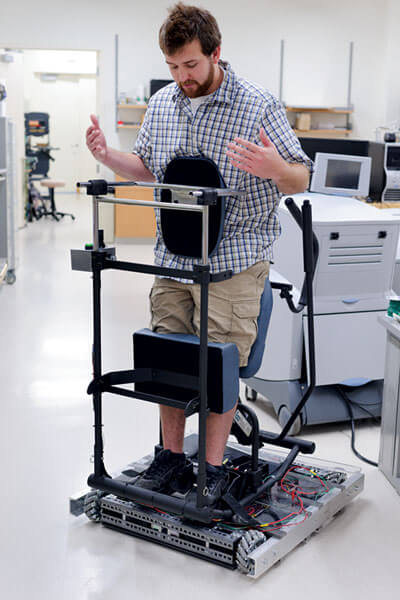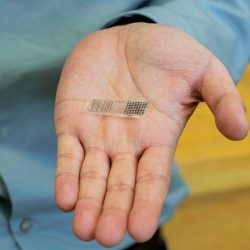Mobility Marvel

Engineering student Bret Olson demonstrates a potentially life-changing device built for a surgeon paralyzed from the waist down, with intricate wheels capable of turning in any direction. Photo: Jeff Miller.
Engineering students help a surgeon get back on his feet in the OR.
After a tragic fall left Delaware surgeon Garrett Cuppels paralyzed from the waist down, he lost the critical ability to stand and comfortably move across an operating room. Determined to give Cuppels hope to return to orthopedic surgery, a team of five UW biomedical engineering students developed a device they named the standing paraplegic omni-directional transport (SPOT).
At the heart of the UW’s biomedical engineering program is a design class: for one credit, students tackle biomedical challenges proposed by real clients, including clinicians, researchers, and engineers in the industry. For Bret Olson x’12 and the rest of his team, earning that credit became secondary. The foremost goal, he says, was to get the doctor back on his feet, thanks to a standing wheelchair the students envisioned.
“We have the unique opportunity to change someone’s life,” Olson says. “Many projects help facilitate research, but it’s only so often we get to interact with the people we’re helping.”
The students have devoted hundreds of hours during the past year to developing SPOT: they’ve visited hospitals, raised money for parts, and spent essential time building it. And they’ve stayed in touch with Cuppels throughout the process, incorporating his ideas and making sure that what they are developing fits his standards.
SPOT’s omni-directional movement capabilities set it apart from other devices. “Dr. Cuppels will have the ability to move in any direction extremely quickly,” Olson says. “What we try to perfect is the precision of movement.” After the team finishes constructing SPOT this semester, Cuppels will likely go through a residency to adapt to a new way of moving about the operating room.
Olson says this project demonstrates how biomedical engineering can produce immediate results, adding, “It has been so fulfilling to see how Dr. Cuppels appreciates engineering and the mechanical build of our device.”
Published in the Fall 2012 issue



Comments
No comments posted yet.